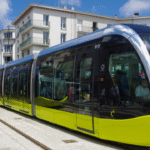Detour sign are a critical component of road safety and traffic management, guiding drivers, pedestrians, and construction crews through alternative routes when normal pathways are obstructed. Whether due to road construction, accidents, or maintenance work, detours ensure smooth traffic flow while minimizing disruptions and hazards.
This article explores the significance of detour sign, their role in preventing accidents, compliance with traffic laws, and best practices for their placement and visibility. By understanding how detour sign function, drivers and city planners can contribute to safer and more efficient roadways.
What Are Detour Sign?
Detour sign are temporary traffic control devices that redirect vehicles and pedestrians away from closed or hazardous sections of the road. They are typically bright orange with black lettering (in the U.S.) or yellow and black (in some other countries) to ensure high visibility. Common detour sign messages include:
- “DETOUR AHEAD” – Warns drivers of an upcoming route change.
- “FOLLOW DETOUR” – Directs motorists to stay on the designated alternate path.
- “ROAD CLOSED – USE DETOUR” – Clearly indicates that the primary route is inaccessible.
These signs work alongside arrows, barricades, and cones to create a safe, organized detour route.
The Role of Detour Sign in Road Safety
A. Preventing Accidents and Confusion
Without proper detour sign, drivers may suddenly encounter blocked roads, leading to abrupt stops, wrong-way turns, or collisions. sign provide advance notice, allowing motorists to adjust their speed and direction safely.
B. Reducing Traffic Congestion
When a road is closed without a clear detour, vehicles may circle the area searching for alternative routes, worsening congestion. Well-placed detour sign streamline traffic flow by guiding drivers efficiently.
C. Protecting Construction Workers and Pedestrians
Roadwork zones are high-risk areas for accidents. Detour’s sign keep vehicles away from workers, reducing the likelihood of injuries or fatalities. Pedestrians also benefit from clearly marked alternate pathways.
D. Compliance with Traffic Laws
Ignoring detour can result in fines or legal consequences. Authorities enforce detour routes to maintain order, and compliance ensures smoother traffic operations.
Key Features of Effective Detour Sign
For detour sign to function optimally, they must meet certain criteria:
A. High Visibility
- Bright Colors: Fluorescent orange or yellow backgrounds with bold black text.
- Reflective Materials: Ensures readability at night or in low-light conditions.
B. Clear and Concise Messaging
- Simple wording (e.g., “DETOUR →”) avoids confusion.
- Arrows should point unmistakably in the correct direction.
C. Proper Placement and Spacing
- Advance Warning Signs: Placed well before the detour to give drivers time to react.
- Directional Signs: Positioned at every critical turn to prevent wrong-way driving.
- Final Confirmation Signs: Reassure drivers that they are still on the correct detour path.
D. Consistency with Traffic Standards
Detour’s sign must follow national or regional traffic control guidelines (e.g., MUTCD in the U.S.) to ensure uniformity and predictability.
Common Challenges with Detour Sign
Despite their importance, Detour’s sign can sometimes fail due to:
A. Poor Placement
- Signs hidden behind trees, buildings, or other obstacles.
- Insufficient spacing between warning signs and the actual detour point.
B. Vague or Missing Directions
- Unclear arrows or lack of follow-up signs can lead to wrong turns.
- Over-reliance on GPS navigation instead of physical signs.
C. Weather and Environmental Factors
- Heavy rain, snow, or fog can obscure signs.
- Wind may knock over temporary sign stands.
D. Driver Negligence
- Some drivers ignore Detour’s sign, assuming they can pass through closed roads.
- Distracted driving (e.g., phone use) leads to missed detour cues.
Best Practices for Implementing Detour Sign
To maximize effectiveness, traffic managers and construction crews should:
A. Conduct a Traffic Flow Analysis
- Study peak traffic hours to schedule detours during low-activity periods when possible.
- Assess alternative routes for feasibility (e.g., avoiding narrow streets).
B. Use Multiple Signage Layers
- Early Warning Signs (e.g., “DETOUR 1 MILE AHEAD”).
- Directional Signs (e.g., “TURN LEFT FOR DETOUR”).
- Confirmation Signs (e.g., “DETOUR ROUTE – STAY ON THIS PATH”).
C. Enhance Nighttime Visibility
- Reflective coatings and LED-enhanced signs improve nighttime recognition.
- Temporary street lighting near detour points can help.
D. Monitor and Adjust as Needed
- Traffic supervisors should observe driver behavior and adjust sign placement if confusion arises.
- Public announcements (via radio, apps, or digital billboards) can supplement physical signs.
The Future of Detour Sign: Technology and Innovations
As smart cities evolve, Detour’s sign is also advancing:
A. Digital Detour Sign
- Electronic message boards that update in real-time based on traffic conditions.
- GPS-linked detour notifications in navigation apps (e.g., Waze, Google Maps).
B. AI and Traffic Prediction Systems
- AI-powered traffic management can optimize detour routes dynamically.
- Drones may assist in monitoring detour compliance and sign placement.
C. Solar-Powered and Smart Signage
- Energy-efficient signs with built-in sensors for better responsiveness.
Conclusion
Detour sign are indispensable in maintaining road safety, minimizing traffic disruptions, and protecting both drivers and workers. Their effectiveness depends on visibility, proper placement, and adherence to traffic standards. As technology progresses, smarter detour systems will further enhance traffic management.
For drivers, obeying a detour sign is not just a legal obligation—it’s a crucial step in ensuring safer roads for everyone. By understanding their importance, we can all contribute to smoother and more efficient travel, even when the usual path is blocked.






